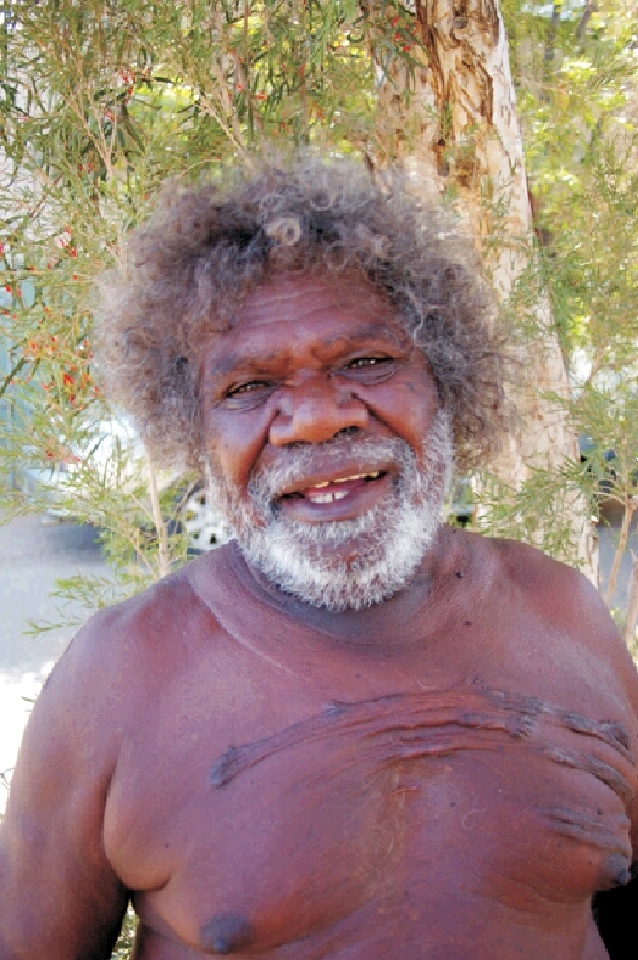George Hairbrush Tjungurrayi

DOB:
c.1943
Born:
Walawala, Kiwirrkurra, WA
LANGUAGE: Pintupi
COMMUNITY: Kintore, NT
George Hairbrush Tjungurrayi, one of the original members of what were to become the Aboriginal art movement, was born around 1943 in his country North West of Kiwirrkurra, located in the Gibson Desert in Western Australia. George's 'sisters' are Naata Nungurrayi and Nganngi (Nancy) Nungurrayi, both well-known artists like George. George and his family lived a traditional life until they came out of the desert via Mt Doreen Station and Yuendumu. In 1962, George walked to Papunya as a guide for Jeremy Long's Welfare Branch patrol.
In 1971, school teacher Geoffrey Bardon encouraged some of the senior men to paint a blank school wall. George's 'uncle', Charlie Tarawa Tjungurrayi, was one of the men involved. The school murals sparked immense interest and is seen as the catalyst of the Papunya art movement and the beginning of the Aboriginal Art Movement.
George served as an 'apprentice' to the senior artists in the Papunya art community. He was surrounded and encouraged by some of the great artists in the Aboriginal art movement, and in 1976 he began to paint in his own right after encouragement from Nosepeg Tjupurrula, one of the founding artists of the Papunya art movement and a leading identity.
Whilst his early works resemble that of some of the great Papunya masters, George soon developed his own distinctive style. George has perfected a minimalist and abstracted style of painting that is characterised by transverse parallel lines that pulse with subtle optical rhythm. While there are aesthetic parallels with works created by contemporary Western artists of the Op-art movement, George's works are based on his country and culture. George's artworks symbolise ancestral journeys and ceremonial body paint. In particular, George paints the Tingari stories of his ancestral country which covers the sites around Kiwirrkura, Lake Mackay, Kulkuta, Karku, Ngaluwinyamana and Kilpinya. Professor Vivien Johnson has also suggested that his striking imagery is drawn from the distinctive Western Desert style of 'fluted' carving: fine parallel lines incised into the wood and coated with ochres which embellished men's ceremonial boomerangs and shields.
The Tingari cycle embodies a vast network of Aboriginal Dreaming songlines that traverse the Western Desert region of Australia. Locations and events of the Tingari cycle frequently occur as the subject matter of Aboriginal art from the region. In Pintupi narratives, a group of Tingari men (ancestral elders) - who were usually followed by groups of women and children - travelled over the Western Desert area performing rituals and creating the country. Deep knowledge of Tingari business is still very secretive and restricted to men in the community who hold an appropriate level of seniority. There are however public stories that do not disclose secret/sacred knowledge.
George's first solo exhibition was in 1997 at Utopia Art Sydney and was quickly followed by another in 1998 at Gabrielle Pizzi in Melbourne, which was a sell-out and received a rave review from art critic Robert Rooney. By the end of the decade, George Hairbrush Tjungurrayi was one of Papunya's most sought-after painters. George has continued to exhibit throughout Australia and internationally. He was a finalist in the Wynne Prize 2007, and in 2006 George Tjungurrayi was Highly Commended in the 34th Alice Prize. In 2003 he was voted as one of the "50 Most Collectable Artists" by Australian Art Collector magazine. His son Jake James Tjapaltjarri also a collectible artist.
Johnson explains that George's nickname 'Hairbrush' is presumably inspired by his curly hair which sticks out in every direction as though it had never felt the touch of one.
